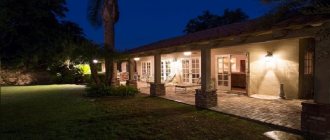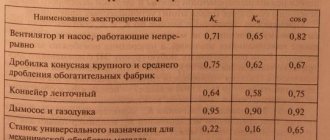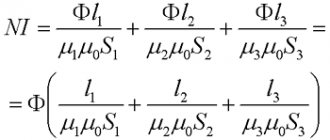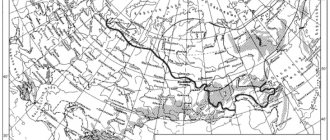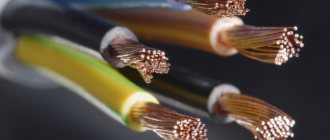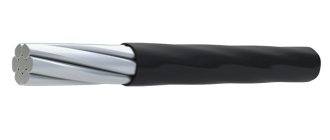External street lighting in the city or in rural areas is the most important point in providing comfortable living conditions for citizens and the movement of drivers. The goals of modern street lighting of roads and other areas are both life safety and improving the aesthetic qualities of a populated area.
There are a number of state norms and rules that govern the lighting system of cities and villages.
Requirements for street lighting.
SNiP 23-05-95* impose special requirements on lighting systems related to the level of reliability and quality of equipment installed along highways. According to these standards, when choosing and installing lighting equipment, it is necessary to take into account the following important factors:
— reliability of fastening of lamps, namely, when installing them, potential wind and power loads should be taken into account;
— the optimal number of lamps to ensure illumination of absolutely all sections of the road;
— correct directions of light flows, which will not blind drivers on any sections of highways;
— ensuring safety in terms of the absence of risks of short circuits and fires.
Road lighting is strictly regulated by Russian standards, which require that city roads and expressways be illuminated, taking into account their category and congestion.
There are 3 categories of street objects:
A – highways and main streets of the city with traffic flow of more than 3000 cars/hour in both directions. Illumination standard 20 lux. B – regional roads with less than 3000 vehicles/hour – 10-15 lux. B – local roads 4-6 lux. When the traffic flow intensity is more than 2000 units/hour, the degree of protection of lighting devices must correspond to IP 54 and higher.
Road lighting
Over the past few years, the world has seen rapid development of modern trends in the field of lighting equipment. The development of LED lamps for various areas of use is actively underway. It can be noted that road lighting is one of the important areas of application of LED lamps, since mercury and sodium analogues are already inferior in their performance to the characteristics of LED lighting. We are talking about longer service life of LED devices, their excellent light output and fairly economical energy consumption, as well as lower costs for maintenance and maintenance.
You can read more about lighting standards in the following article:
Advantages of LED street lights.
Street LED lamps last an average of 10 years, so over time there are significant savings on regular maintenance of main lighting fixtures. The durability of LED lamps allows you to replace light sources as their expiration date expires or when the lamp burns out completely.
Among the undoubted advantages of an LED flashlight is its protection from acts of vandalism. As a rule, the structure body is assembled from high-strength material, and the electrical cable is securely fixed to the pole. LED lights work in any climatic conditions: in the summer heat and winter cold, without burning out from excessive heat or freezing from the cold.
LED flashlights are quite easy to recycle, as the lamps are environmentally friendly. You can also save a lot of money in this process. LED lamps have a sealed housing, which protects the lighting device from dirt and dust. Thus, the service life of the LED street lamp becomes significantly longer, which is an important factor for the management company.
Road lighting
A high level of performance characteristics primarily depends on a number of important indicators. Here it is necessary to note light output, color flow, increased resistance to external factors in the form of precipitation and various atmospheric phenomena. Modern manufacturers do not stop there and apply various innovations that ultimately improve performance characteristics. For example, they use solar energy, which significantly reduces the cost of operating lighting systems.
LED street lights do not emit excess heat during operation, which also remains a significant advantage. Main lighting lasts a long time, works efficiently and allows the network owner to save money.
To select a street LED lamp, you need to contact professionals who will select the optimal and inexpensive LED design option for the needs of the company.
You can read more about the benefits of LEDs in the following article:
Lamp manufacturers agree: TOP 5 advantages of LEDs
Street lighting standards in rural areas
In such territories, all issues are resolved between residents and the farmer (owner or tenant) without any outside interference.
In such a situation, in order to transfer the energy networks to the balance of the municipality (something similar to deprivatization), you will have to go through several circles of bureaucratic hell.
And this is only possible after bringing the energy system (for a long time considered de facto ownerless) into complete order.
The service life of the lamp in a rustic street lighting lamp is approximately 1.5 years under average operating conditions: 12 hours on, 12 hours off.
Standardization of street lighting In road tunnels, this indicator ranges from 50 to 750 lux and depends on the following factors;
- tunnel length;
- tunnel type (closed, having a wall with closed openings).
The requirements for open parking lots and fuel refueling places are as follows: they must have an average horizontal illumination level within 2 ÷ 10 lux.
Attention LED street light sources The requirements and rules for choosing lamps for street lighting come down to the selection of a type of product that consumes little electricity, is resistant to climatic factors, has a long service life and, in addition, can be installed without problems. All these factors correspond to main LED luminaires
Street lighting in rural areas law
This article describes in detail the law about street lighting in rural areas, and everything you need to know about it. Currently in Russia, most small settlements do not have the proper level of street lighting.
This makes life difficult for local residents, especially in the winter.
Responsibilities for street lighting fall on municipal authorities.
But, as a rule, they do not provide rural settlements with the proper level of lighting.
What to do in such a situation and where to go for citizens to protect their rights.
Features of installing pillars and supports
How to properly install street lighting
Installation of LED light sources can be carried out on power poles, masts and special lighting supports made of metal or concrete. From the edge of the roadway, if there is a curb on main streets, the distance must be at least 1 m, on other types of streets - 0.6 m. In the absence of a curb, this norm is 1.75 m or more. At the intersections of streets, avenues, and roads, the standards specified in the PUE prohibit the installation of lighting poles and supports closer than 1.5 m from the curve. The supports can be installed on the dividing strip if the road width is more than 5 m. The distance to windows, balconies, and terraces of a residential building is also specified. It must be more than 1 m.
The standard distance between supports must comply with the rules established in the same PUE. The distance between the supports, which is called the span, can be from 40 to 750 m, the height of the support itself is from 8 to 54 m. The indicators depend on the following factors:
- voltage indicated in kW;
- distance between wires, indicated in m;
- distance of the wire to the ground, indicated in m.
Project specialists perform special complex calculations and the project for lighting a specific object specifies specific data that must be observed during installation.
Standardization of lighting for streets, avenues, alleys, and roads with different types of surfaces depends on many factors that must be taken into account when creating a lighting project. Only specialists know the nuances of designing street lighting, and are also well versed in the selection of economical light sources, the rules for their installation and connection to the power supply. Therefore, such work is carried out in specialized design organizations and undergoes an examination for operability, as well as the feasibility of performing a specific type of lighting.
Power supply for lighting networks
To power outdoor lighting networks, outdoor lighting boards (SCHNO) or outdoor lighting control cabinets (SUNCO) are provided, which are connected to transformer substations or ASUs of buildings. In some cases, more often in rural areas, SHUNO is connected to the mains of 0.4 kV overhead lines. If the SHUNO is placed on the ground, then a shield with a protection device is installed on the overhead line support that prevents the line from being disconnected in the event of a short circuit in the SHUNO power cable. The need to install a shield with a protection device on a support is due to the requirement of GOST R 50571.4.43-2012 (clauses 433.2; 434.2 and Appendix C), according to which the length of the branch to the protection device must be less than 3 meters.
In large cities, with large outdoor lighting installations, additional rooms are attached to transformer substations, in which switchboards with protection and control devices are installed.
External lighting lines for courtyards and alleys are connected to street lighting lines (except for category A streets).
Requirements for power supply of outdoor lighting networks are set out in paragraphs. 6.3.15…6.3.24 PUE, 7th edition.
Options for organizing courtyard lighting
Today, lighting of the local area can be done in several ways. The first option for organizing courtyard lighting involves placing a wall lamp above the entrance canopy.
Entrance lighting
Any type of lamp, as well as light source (LED, fluorescent, etc.) can be used here.
Recently, economical light sources have begun to be used for these purposes, which allow saving energy, which is very important for this type of lighting. This lighting option allows you to illuminate only the area in front of the entrance. Therefore it is rarely used
Usually it comes in combination with other lighting options. The second option for lighting the yard involves placing a wall-mounted street lamp above the canopy at approximately a height of 8.5 meters from ground level.
Second lighting option
In this case, the lamps should be located at an angle of 25 degrees to the horizon. This lighting option provides a much larger area of illumination for the yard, which will cover not only the area in front of the entrance, but part of the roadway. The third option for courtyard lighting. It involves the use of both types of lighting devices described in the previous versions.
Third option for courtyard lighting
In addition, floor lamps are used to illuminate the local area. The distance between them is also regulated by regulatory documents, as are lighting standards. With the help of such lighting devices placed along the road, you can provide high-quality illumination of the roadway, as well as playgrounds and parking lots located in the courtyard of an apartment building.
Yard lighting with lanterns
The most effective way to illuminate the local area is to use both lanterns and lamps placed above the entrance door to the entrance.
Recommendations for lighting a stretch ceiling
The characteristics of the material impose certain restrictions on the devices used. PVC film melts when the temperature rises to 60-70°C, fabric - about 80°C.
Therefore, incandescent lamps do not combine well with suspended ceilings. You can only take low-power ones - up to 40 W. And for halogen, the restrictions are even stricter - no higher than 35 W.
With stretch fabrics, it is recommended to use LED or energy-saving lamps that do not heat up during operation. Of these, the first type is preferable, they are more durable and consume less electricity. Energy-saving lamps are only effective when used continuously; when switched on, they consume a lot of electricity and do not immediately light up to full power.
Ceiling lights are distributed over the surface evenly or in groups, highlighting certain areas. When drawing up a layout, take into account the minimum distances:
- from the edge of the canvas should be at least 20 cm;
- from the seam (if the film is soldered) - 15 cm;
- between adjacent devices - 30 cm.
Read more: How to place spotlights on a suspended ceiling
The lamps are attached not to a thin sheet, but to the ceiling through embedded platforms, which are installed in advance. Therefore, it is necessary to select models, calculate the number of devices and develop a diagram of their location before installing the stretch ceiling.
Enabling Regions
There is no shortage of new lighting systems in the regions - in Russia there are more than 600 factories that produce LED lamps, about a third of which also make street lighting. The industry's annual turnover is estimated at more than 100 billion rubles.
True, so far, according to the traffic police, only in 26 constituent entities of the Russian Federation this year measures are planned on regional roads to arrange lighting lines for local potentially dangerous areas. At the same time, in 13 Russian regions, a noticeable increase in all three main indicators of accident rates was recorded at night on regional roads within populated areas, where such lighting is mandatory, but is actually absent.
But within the framework of the national project, the regions are expected to change the situation. For example, in the Ulyanovsk region it is planned to build 54 km of outdoor lighting networks in the next two years and install 1 thousand 351 lamps on transit sections of highways in 32 settlements. The region already has positive experience: according to the regional Ministry of Energy, Housing and Communal Services and the Urban Environment, 12 thousand LED lamps installed in a number of districts in 2015 over three years resulted in savings of more than 180 million rubles.
In Kabardino-Balkaria (KBR), in accordance with the national project, 25 km of regional roads will be illuminated in 2019, while in 2022 - only 7.5 km. In general, by 2024, about 400 km of regional roads out of the existing 2,940 km will become brighter. In Bashkiria, 75 million rubles will be allocated for lighting highways in 2022. In the Pskov region, where more than half of the settlements through which federal highways pass do not have lighting, they plan to correct the situation and illuminate them all by 2022.
Experience in using lighting control systems. Yaroslav Dolinsky, Altai Avtodor
Recently, in our area, in accordance with the program to improve road safety, as well as as part of the reconstruction of road sections, a lot of work has been done to equip electric lighting lines in populated areas.
Yaroslav Dolinsky, head of service of the Altai Avtodor
With the increase in the length of lines, the need for an automated control system arose. Work on its implementation was carried out in parallel, and in 2012, due to cost savings on road maintenance, we managed to combine all lighting installations (OU) into a common control system. Information from the OS can be received in real time by both the contractor and the customer.
Since 2010, all 107 km are connected to the system. The implementation of the system allows you to automate all energy saving work. Thus, it allows you to systematically reduce the illumination of the roadway by regulating the voltage in the network from 220 to 180 volts. Also, since 2010, we have been gradually introducing the installation of LED lamps, but due to the high cost, we are not always able to convincingly prove the payback period. However, this direction is promising; with the development of technology, we see an increase in luminous efficiency (lm/W) and a simultaneous reduction in cost, which shortens the payback period.
In 2011, we illuminated a two-level interchange and installed about 500 LED lamps.
What are the difficulties and problems? This is the reliability of the lines. Their content - control systems, data transmission systems, dimming systems - all comes to the fore. Maintenance, on-site visits, replacement of some line elements, all this costs us a pretty penny - both for the contractor and, accordingly, for us. I would like to draw the attention of manufacturers to this.
1 area of use
This standard establishes standards and methods for calculating stationary artificial lighting of public roads (hereinafter referred to as roads) outside populated areas, including road and roadside service facilities.
This standard is used in the design and operation of newly installed or reconstructed stationary artificial road lighting.
This standard does not apply to:
- lighting of roads not related to public roads, such as roads of industrial, construction, forestry and other production enterprises, roads intended for temporary use, roads located in special exclusion zones and constructed for defense needs or exclusively for sporting purposes;
- lighting of road tunnels and passages under overpasses;
-architectural, functional, decorative and advertising lighting of road construction elements located within the right-of-way and on the roadside.
Lighting of parks and neighborhoods - comfort and personal safety
In public recreation areas, three types of lighting with different functionality are combined.
- Utilitarian - devices for lighting alleys, playgrounds, sports and entertainment areas, providing good visibility.
- Decorative - light compositions, spotlights and lanterns that highlight the beauty of the landscape and complement the architectural ensemble.
- Contour - decorative or signal lighting of steps, stairs, structures, fountains, flower beds using built-in lamps.
Standards for street lighting
Average horizontal illumination is the indicator that is the main one when implementing standardization. It is measured in lux (lux), depending on the surface that needs to be illuminated in the evening and at night. Illumination is the amount of luminous flux incident on the illuminated surface. The second most important characteristic is brightness. It represents the amount of luminous flux reflected from a certain amount of road surface. Illumination is measured by an instrument called a lux meter. Many devices have a combined design. All of them have sensitivity adjusted to the perception of human vision.
The standards depend on the type of main streets and roads, and the intensity of vehicle traffic. There are 3 types of main roads and streets:
- citywide, designated by the letter A;
- district – B;
- local -V.
The number of vehicles passing along the roadway per hour can be:
- no more than 500;
- more than 500;
- over 1000.
Depending on these factors, the average horizontal illumination in lux is indicated in Table 1
Table 1
Standards for lighting impassable parts of roads, streets, etc. are also regulated and they must correspond to the data indicated in the table. 2
table 2
The average horizontal illumination of exhibition areas, stadiums, parks and walking areas ranges from 1 to 10 lux and depends on the functional features of the object.
In vehicle tunnels, this indicator ranges from 50 to 750 lux and depends on the following factors;
- tunnel length;
- tunnel type (closed, having a wall with closed openings).
The requirements for open parking lots and fuel refueling places are as follows: they must have an average horizontal illumination level within 2 ÷ 10 lux.
Illumination of pedestrian crossings
The illumination of surface pedestrian crossings has the most important task: to identify a pedestrian as best as possible for drivers. Accordingly, the illumination of such passages in commercial and industrial areas must be at least 15 lux, and in residential areas - at least 6 lux on a horizontal surface.
If ground crossings are marked with specialized light beacons or markers, it is recommended to install them at a height of 2-3 meters so that drivers can notice them from afar and slow down in time. For this purpose, contrasting multi-colored light bulbs are recommended. The brightness of these devices must be at least 300 cd/m. The permissible flashing frequency is 40-60 flashes per minute.
The average horizontal illumination for pedestrian crossings is:
- underground passages – 75 lux;
- stairs of underground pedestrian crossings – 20 lux;
- closed bridge crossings equipped with transparent walls – 75 lux;
- stairs and platforms of closed bridge crossings equipped with transparent walls - 50 lux.
Underground pedestrian crossings are equipped with lamps with diffusion diffusers or a protective angle of at least 15°.
The lighting intensity can be increased in capitals, large historical cities, resorts, and ports.
It is allowed to reduce the lighting level:
- by 30% if traffic intensity has decreased to ⅓ of the maximum;
- by 50% when traffic intensity is reduced to ⅕ of the maximum.
Complete or partial shutdown of artificial lighting at night is prohibited:
- in car parks;
- pedestrian bridges and alleys;
- in rural villages;
- fire, utility and internal passages.
Illumination of vehicle tunnels
In transport tunnels and near-tunnel facilities, it is advisable to use two types of lighting:
- stationary working - must provide for night and day modes and create illumination at such a level at any time of the day to ensure the safety and visual comfort of road users;
- emergency - emergency exits and directions to them are equipped with light indicators.
The level of illumination in tunnels is based on the distance required for safe braking.
The initial values of this indicator are as follows:
| Speed in km/h | 40 | 60 | 80 | 100 | 120 |
| Braking distance in meters | 25 | 55 | 100 | 155 | 220 |
Tunnels can be long or short, curved or straight, one-sided or two-sided. All this data must be taken into account when calculating the optimal illumination to create sufficient visibility, guided by State building codes.
The average illumination value of the road surface in tunnels longer than 60 m at night in the horizontal plane should be 50 lux and higher.
Symmetrical lighting is used in tunnels with traffic in both directions, and counter lighting is used in one-way tunnels.
It is important to maintain a smooth transition between natural and electric lighting in tunnels when entering or exiting. To do this, there are 4 brightness zones:
- exit/entrance;
- ultimate;
- transitional;
- internal.
Unusual “daylight” light
You can determine whether modern LED lighting is used on a particular section of the road by its color. The bright yellow light of street lamps, familiar to many, is produced by sodium arc tube lamps (HPS), which power almost three-quarters of all road lamps. Perceived “white” LED lighting currently accounts for only about 16% of the total number of lanterns. But their share will grow: the government plans to completely ban the use of non-energy efficient light sources from 2022.
Compared to the most common sodium lamp HPS 250 W, even a standard LED lamp with the same luminous flux indicators consumes half as much energy. At the same time, the so-called white daylight of LED lamps is perceived as unusual by many, but in terms of color rendering, LED lamps are three times better: in their rays, the boundaries of objects and their natural color are more clearly visible.
The cost of LED lamps is usually two to three times higher than sodium lamps. But due to energy savings, they pay for themselves within three to four years and, as a rule, have a service life of at least 50 thousand hours, which is three times longer than the service life of old-generation lamps. In addition to direct energy savings, LED lighting can reduce costs both on the power of energy supply lines and due to the ability to place lighting poles further apart from each other.
LED lamps also have disadvantages. For example, despite the better visibility of objects, on a wet road their light can create a so-called “zebra”, an alternation of areas with increased contrast in strong and low light. This problem is usually solved by installing optical diffusers.
Terms for calculating illumination on highways and roads
The GSN V.2.5-28: 2022, which is currently relevant in Ukraine, provides the following deadlines:
- Glare – when a road user experiences discomfort or reduced ability to see objects or details due to an inadequate distribution or range of brightness and contrasts in the environment;
- GRl – maximum permissible gloss index;
- discrimination - when an object is noticeable against the background of its surroundings;
- visual acuity – distinguishing small individual details of small separation;
- UDS – street and road network;
- operational illumination (Eex, determined in lux) - the minimum permitted illumination on a certain surface;
- flood lighting – a significant increase in illumination compared to normal;
- general lighting – divided into uniform and localized. Placed in the upper zone of the room or relative to objects that need to be illuminated;
- visual discomfort - a feeling of eye strain and inconvenience in distinguishing objects. The cause may be incorrect brightness distribution. This leads to absent-mindedness, decreased concentration, visual fatigue, and distraction;
About calculating illumination
More details
- safety factor (Kz) is an important indicator with which the reduction in the pulsation coefficient of illumination and luminous flux intensity that occurs during operation due to aging, contamination of devices, as well as a natural decrease in the reflective properties of surfaces is calculated. Determined by the following formula:
- Emax and Emin are the highest and lowest indices of illumination fluctuation, denoted in lux, and Eser is its average value, also in lux;
- semi-cylindrical illumination (Ents) - the saturation of space with light and the effect of shadow formation for an observer who moves along the street parallel to its axis. It can be calculated using the engineering method;
- pedestrian zone - a certain place intended exclusively for pedestrian traffic, where cars are not allowed (except for special equipment, vehicles for the disabled, ambulances);
- indicator of visual discomfort - a criterion that evaluates uncomfortable brightness, when the brightness is distributed unevenly in space and causes unpleasant sensations. Calculated using the formula:
M is the desired indicator;
Li- brightness of the source that glitters, cd/sq.m;
ω is the size of the solid angle of the brightness source, avg;
φ0 is the index of the position of the brightness source relative to the visual line;
La - adaptation brightness, cd/sq.m
- flicker effect - when parts of the lamp flicker steadily, creating glare from the car's upholstery. This irritates the driver, distracts his attention, causing a dangerous situation on the road;
- background (background) - a surface located around a certain object, on which it can be distinguished. Backgrounds are available: light, medium, dark.
We select the right lighting devices to illuminate the roadway
The quality of street lighting depends on the correct choice of lamp and its placement. The selection of lighting equipment for roads is regulated by GOST. For an outdoor lighting system, luminaires must meet a number of requirements:
Main lamp
- have simple and unpretentious maintenance;
- have reliable protection from a variety of climatic conditions (snow, rain, hail, strong gusts of wind, etc.);
- have a high moisture resistance class (at least IP55);
- have anti-vandal protection;
- consume a minimum of electricity and at the same time produce a powerful luminous flux;
Console lamp
long service life of both the lamp and light sources; have a simple design and blend harmoniously with the supports
This is especially important (from an aesthetic point of view) for city roads: the presence of an optical system to create a directional light flux. Most often, lighting fixtures have a suspended mounting method, which allows them to be effectively mounted on building facades or special supports (cantilever-type lamps)
The distance between the pillars should be 50 meters, and their height can vary from 5 to 12 meters depending on existing needs
Most often, lighting fixtures have a suspended mounting method, which allows them to be effectively mounted on building facades or special supports (cantilever-type lamps). The distance between the pillars should be 50 meters, and their height can vary from 5 to 12 meters depending on existing needs.
Operating principle and design of luminaires for highways and streets
Office lighting
The principle of operation of the products is based on passing electric current through LEDs located in the housing to produce a luminous flux that is as close as possible to daytime natural light. Such lamps are made from durable vandal-proof materials. They have a degree of protection of at least IP 65, which allows you to reliably protect internal structural elements from negative environmental influences (dust, water, snow, aggressive environments, wind). They are installed on special metal or reinforced concrete supports using a console, therefore they have another name - cantilever. Another feature of the products is that they turn on instantly. Many luminaire models have secondary optics, which improves technical characteristics.
The design of the product consists of the following parts:
- consoles or brackets;
- housings;
- optics, which consists of LEDs and a diffuser;
- LTD driver or also called power supply.
The purpose of the console and bracket is to quickly and securely secure the product to the support. Depending on the characteristics of the illuminated object, the installation height and tilt angle are selected. The body is made of aluminum or impact-resistant plastic. The optics provide a wide, medium, narrow or asymmetrical dual beam of light. The analysis showed that LED lamps with a wide beam of light are most often used on roads.
Modern LED lamps for road lighting
The most promising and economical luminaires for roads are products based on LEDs.
They are replacing fluorescent, gas-discharge mercury, sodium and lamp lighting, because... resistant to external factors, have high energy efficiency, are easy to install, tolerate temperature fluctuations, are environmentally friendly and safe. They operate in the temperature range of minus 60 to plus 50 0C, are not afraid of power surges, vibration and other mechanical influences, do not require maintenance during operation, and operate in difficult climatic conditions. Service life of at least 50,000 hours. Lighting roads with such lamps, which are called main ones, solves the problem of visibility. They provide comfort for drivers and pedestrians, as well as road safety.
3Terms and definitions
This standard uses terms according to GOST R 55392, GOST R 56228, as well as the following terms with corresponding definitions:
3.1 road surface brightness
L
,
cd•m: The brightness of the road surface at a given point, created by a lighting installation (OU), in the direction of the vehicle driver (observer), located under standard observation conditions in relation to the specified point.
3.2 standard observation conditions:
Conditions under which the observer's eye is located at a height of 1.5 m above the road surface and removed from a given point at a distance at which the angle between the line of sight directed to the specified point and the plane of the road lies in the range of (1.0 ± 0.5) °.
3.3 average brightness of the road surface
,
cd•m: The brightness of the road surface relative to an observer located on the axis of a given lane, averaged over a given section of the road.
3.4 overall brightness uniformity
The ratio of the minimum value of road surface brightness to its average value.
3.5 longitudinal brightness uniformity
The ratio of the minimum value of road surface brightness to its maximum value, determined along the axis of the traffic lane on which the observer is located.
3.6 illumination on the road surface
,
lux: Illumination on the road surface at a given point, created by the OS.
3.7 average illumination
,
lux: Illumination on the road surface, averaged over a given section of the road.
3.8 uniformity of illumination
The ratio of the minimum value of illumination on the road surface* to its average value ._______________*The text of the document corresponds to the original. — Note from the database manufacturer.
3.9 threshold increase in brightness
,
%: A measure of the glare of the direct light of lighting devices (L) in the OU on the driver of the vehicle.
3.10 peripheral illumination ratio
SR:
The ratio of the average illumination on the surface of the roadside to the average illumination on the surface of the traffic lane adjacent to the shoulder.
3.11 section with standard roadway geometry:
A section of road, the carriageway of which is constant in width, is straight and has a length that is determined by standard observation conditions.
Notes
1The straightness of the roadway of the site is determined by the following conditions: longitudinal slope - no more than 30%, radius of curvature for curves in plan - no less than 3000 m, radius of curvature in the longitudinal profile - no less than 70,000 m for convex road surfaces and no less than 8,000 m for concave road surfaces.
2The minimum length of a section with standard geometry corresponds to 60 m plus the length of three spans between substations.
3.12 section with non-standard roadway geometry:
A section of road that has deviations from standard geometry
Note - Examples of sections with non-standard geometry are: turns, roundabouts, transitional express lanes, entrances and exits of overpasses, curved sections (in plan and profile), etc.
3.13 operation factor
MF
:
The ratio of the average illumination on a section of the road created by the OS at the end of the established service life to the average illumination on the same section created by the OS at the beginning of operation.
Energy efficient equipment and lighting control systems
Igor Lazurenko, energy engineer of the Chernozemupravtodor FKU, spoke in his report about the use of energy-efficient lighting equipment and lighting control systems, and about increasing the level of safety at a specific facility .
The amount of visual information that is perceived by the driver directly influences the adoption of adequate actions when the traffic situation changes while driving. A factor such as the presence of lighting in the required places is included in the first group of factors that can influence the risk of an accident. An analysis of the impact of measures to improve the transport and operational condition of the road network shows that the average reduction in the number of accidents with casualties as a percentage of the initial level (i.e. before the installation of artificial lighting) is 25%.
Artificial lighting is made in the form of the use of reinforced concrete and metal supports for the installation of cantilever lamps. The lamps used are ZhKU-16 with DNAT and DRL lamps, LED and induction lamps. Autonomous lighting equipment is used to illuminate bus stops, pedestrian crossings and bridges where there is no possibility of connecting to power grids.
Comparison of the costs of electricity consumed by lamps of a stationary electric lighting line and an autonomous lighting system
A few words about energy saving. In 2010, 29 USS-180 energy-saving LED lamps were installed on road sections of the Chernozemupravtodor Federal Institution. Savings in electricity costs on the artificial lighting line in 2011 for this facility amounted to 47 thousand rubles. In 2012 - 54 thousand rubles.
Comparison of the costs of maintaining luminaires for a stationary electric lighting line and autonomous lighting systems
Also in 2011, on sections of roads on artificial lighting lines, 392 lamps were replaced with induction lamps. In 2012, cash savings for these facilities amounted to 325 thousand rubles. This amount is enough to pay for electricity for a year to power a lighting line consisting of approximately 70 lamps.
The constant growth of the car fleet in the country increases the number of road accidents, in which, unfortunately, pedestrians also suffer. One of the reasons for this situation is poor lighting of pedestrian crossings and public transport stops. In the absence of accessible stationary electrical networks, we solve this problem by installing autonomous lighting equipment. We use the principle of collecting electricity from solar panels and its further accumulation in batteries. A fully charged battery provides 3-5 days of operation of an autonomous lighting system. The advantage of such systems is their autonomy and independence from centralized power supplies. Although the use of such systems in Russia is not very widespread, undoubtedly, the future lies with them.
We recognized that these systems are the future. Ordinary consumers also understood this. Thus, the first 11 cases of theft of such systems were registered - iron supports, completely cut down to the base, along with lamps, solar panels and batteries. As they say, “it will come in handy on the farm.”
An example of calculating street lighting of a roadway in a residential area
The calculation of LED street lighting for a highway is based on finding the distance between the lamps. Let’s say the road width is 6 meters, and Ziverd cantilever lamps are installed on poles 9 meters high.
The formula is quite simple:
F = L*K*π/N, where
F is the required distance in meters.
L – road surface brightness. The calculated road belongs to class B3, for which the brightness of the surface is 0.6 cd/m2.
K is the incandescence coefficient, which for an LED device is equal to 1.
π = 3.14.
N is the luminous flux coefficient, which will be 0.05.
Calculation of street lighting with LED lamps with numerical data:
F = 0.6*1*3.14/0.05 = 37.68.
Thus, lights need to be installed every 37.68 meters.
Example of outdoor lighting calculation
Let's look at specific examples of the calculation scheme for calculating outdoor lighting.
Example 1: street and yard lighting
Project data: street and yard lighting. You need to calculate the required number of lamps. The following formula is used for this:
N=E*S*z*k/(F*ɳ)
In this formula:
N is the required number of lamps;
E – indicator of the minimum degree of such a definition as illumination;
S – area;
Z – indicator of uneven illumination of the territory;
K – long-term use accounting factor;
F – indicator of emitted light;
ɳ is an indicator of the reflective abilities of elements.
Keep in mind that the necessary physical characteristics and parameters of lighting devices are indicated in their technical documentation.
Let's say we need to calculate the required number of lighting fixtures in the local area of a new building measuring 250 square meters. m. As a rule, LED spotlights are used to illuminate these areas. Their parameters will be taken into account.
So, first, we fix the value of F. This data is written in the instructions for the spotlight.
Secondly, we find the device power values and the possible luminosity coefficient. In our case, these indicators remained at 40 W power and 90 lm/W luminosity.
Thirdly, we find the value of the network flux F=40*90=3600 lm.
Fourth, we need the value of ɳ. In our case, given that the coverage of the territory is light gray, its reflectivity is 50%.
Fifthly, let's take the standard lighting level - 10 lux.
All that remains is to substitute the numerical values into the formula:
F=10*250*1.1*1.2/(3600*0.5)=1.8
Rounding the resulting value, we get the answer - for a common area of 250 sq.m. It is enough to install 2 LED spotlights with a power of 40 W.
External entrance lighting
2Normative references
This standard uses normative references to the following standards:
GOST 33175 General automobile roads. Horizontal illumination from artificial lighting. Control methods
GOST 33382 General automobile roads. Technical classification
GOST R 54984 External lighting of railway transport facilities. Standards and methods of control
GOST R 55392 Lighting devices and complexes. Terms and Definitions
GOST R 55708 External utilitarian lighting. Methods for calculating standardized parameters
GOST R 56228 Artificial lighting. Terms and definitions
GOST R 58107.2 Lighting of public roads. Mobile method for measuring illumination on road surfaces
GOST R 58107.3 Lighting of public roads. Method for measuring the brightness of road surfaces using a mobile method
Note - When using this standard, it is advisable to check the validity of the reference standards in the public information system - on the official website of the Federal Agency for Technical Regulation and Metrology on the Internet or according to the annual information index “National Standards”, which was published as of January 1 of the current year, and according to the release of the monthly information index "National Standards" for the current year. If a reference standard to which an undated reference is given is replaced, it is recommended that the current version of that standard be used, taking into account any changes made to that version. If a reference standard to which a dated reference is given is replaced, it is recommended to use the version of this standard with the year of approval (adoption) indicated above. If, after the approval of this standard, a change is made to the referenced standard to which a dated reference is made that affects the provision referred to, it is recommended that that provision be applied without regard to that change. If the reference standard is canceled without replacement, then the provision in which a reference to it is given is recommended to be applied in the part that does not affect this reference.
Modern LED technologies.
However, one should get rid of the illusion that such lamps do not require maintenance. Despite the assurances of manufacturers, after 5 years of operation, 1% of even high-quality equipment fails. Bulky and heavy lighting fixtures must be dismantled and sent to the manufacturer, and new ones are installed in their place, which leads to higher maintenance costs.
Some large manufacturers have proposed a fresh solution to this problem. They developed and launched a series of new lamps that allow replacing both the light source and the power source at the location of the problem without dismantling the structure.
Development of integrated lighting
has extensive experience in organizing complex street lighting at various sites
When developing a project, we pay attention to every stage, from examination to installation of structures at the installation site
When designing, we visualize the object so that you can see how everything will look in reality, and we adjust the result taking into account your wishes. We make sure to agree on the price and only after that offer to sign the contract. In addition to installation, we provide warranty service for the supplied equipment, so you can be sure of its stable operation for a long time. We offer to order comprehensive lighting for your facility. Write and ask your questions in the online form or call us at contact numbers. 02/08/2021
Current standards for street and road lighting
Standards are measured in Lux and illumination distribution in Emin/Esr
Main road trunk and citywide outdoor lighting line
- This is a highway, transit route, main city highways with a traffic density of more than 10 thousand units per hour - 300 Lux and 0.35 Emin/Esr.
- These are federal roads and streets outside the city center, with a traffic density of 7-9 t/h. – 200\0.35.
- Central highways that connect streets that lead to main highways, which have a throughput of 4-7 t/h. – 200\0.35.
- Passages related to the main historical roads with a throughput capacity of 3-5 t/h. – 200\35.
- The main streets and roads of the city, located outside the city limits, on which the throughput is from 3-5 t/h. – 200\35.
- The main street and the central city road, on which the throughput is from 2-5 t/h. – 200\35.
Road on a district street
- This includes the connection between transport and pedestrians, which are located within residential areas and highway exits, not taking into account streets with constant traffic. Throughput from 1.5-3 t/h. – 150\25.
- connected roads for transport and pedestrians within production and utility-warehouse areas. Traffic density from 500-2000 t/h. – 6\0.25.
Street, country road near the village
Main street, city shopping center area - 10 Lk. The main street in residential buildings is 6 Lk. Lane and street of secondary importance in residential development - 4 Lk. Road in the village, travel to the territory of the gardening partnership and dacha cooperative - 2 Lk.
Gas station and parking lot (gas station)
The level of illumination is measured by the minimum level of Lux.
- Access route from roads of categories A, B – 15.
- Access route C – 10.
- Filling and draining points for petroleum products – 20.
- Territories with roadways – 10.
Pedestrian paths
- This includes the area near the entrances to sports, entertainment and retail buildings - 20\0.3.
- Main streets for pedestrians located in a historical place – 10.\0.3.
- Park entrance, sanatorium, exhibition, pedestrian street - 60.2.
- A sidewalk separated from the roadway, the main passageways of the microdistrict, the main routes to the central alleys of educational and medical institutions - 40.2.
- Secondary passage to microdistricts, side alleys, and also a secondary entrance to the city park - 20.1.
- Auxiliary entrances to the administrative district park and side alleys - 10.1.
Underground and overground pedestrian path
- Underground passage and tunnel – 75\0.3.
- Ramp, stairs for the tunnel and underground passage – 45\0.3.
- Open pedestrian bridges – 10\0.3.
- Overpass with glass opening – 75\0.3.
- Stairs, observation platforms on glazed passages – 50\0.3.
Entrance to premises and external lighting standards
- The area of the main entrance is 6 lx.
- The area of the emergency and emergency exit is 4 lx.
- The pedestrian path near the main entrance is 4 Lk.
Evacuation route
An escape route that is no more than 2 meters wide is 1\0.025. The evacuation route of particular importance is 0.5\0.025. Large area for evacuation – 0.5\0.025.
Street lighting standards in the city
Below is a list of lighting standards in the city. They should definitely be taken into account when designing street lighting.
The height of placement of lamps on city streets, roads and squares with tram and trolleybus traffic should be taken into account the height of hanging contact wires according to SP 98.13330.2012. But in any case, the installation height of the lamps must be at least 8 m to the rail head for tram tracks and at least 9 m from the roadway level for trolleybus routes. Table taken
Street lighting standards
| № | Illuminated objects | Average illumination Ecp, lux not less | Illumination distribution Emin / Eсr not less |
| 1 | A1 . Highways, federal and transit routes, main city thoroughfares (outside the city center) - with a throughput capacity of more than 10,000 units/hour | 30 | 0,35 |
| 2 | A2 . Other federal roads and main streets (outside the city center) - with a throughput of 7,000 - 9,000 units/hour | 20 | 0,35 |
| 3 | A3 . Central highways connecting streets with access to the A1 (in the city center) - with a throughput capacity of 4,000 - 7,000 units / hour | 20 | 0,35 |
| 4 | A4 . The main historical passages of the center, internal connections of the center (in the city center) - with a throughput of 3,000 - 5,000 units / hour | 20 | 0,35 |
| Main roads and district streets. Road class - B | |||
| 5 | B1 . Main roads and streets of the city of regional significance (outside the city center) - with a throughput capacity of 3,000 - 5,000 units / hour | 20 | 0,35 |
| 6 | B2 . Main roads and streets of the city of regional significance (in the city center) - with a throughput capacity of 2,000 - 5,000 units / hour | 15 | 0,35 |
| Local streets and roads. Road class - B | |||
| 7 | IN 1 . Transport and pedestrian connections within residential areas and access to highways, except for streets with continuous traffic (residential developments outside the city center) - with a throughput capacity of 1,500 - 3,000 units/hour | 15 | 0,25 |
| 8 | AT 2 . Transport and pedestrian connections in residential neighborhoods and access to highways (residential developments in the city center) - with a throughput capacity of 1,500 - 3,000 units/hour | 10 | 0,25 |
| 9 | AT 3 . Transport connections within industrial and communal warehouse zones (in urban industrial, communal and warehouse zones) - with a throughput capacity of 500 - 2,000 units/h | 6 | 0,25 |
| Separate tram track | |||
| 10 | Separate tram track | 10 | — |
Ready solutions
Lighting of class A1 roads Class A1 roads include the most heavily loaded highways. Therefore, the most stringent requirements are applied to their lighting solutions. For the solutions presented here, high-power luminaires with wide luminaires and a large suspension height are used. Lighting of class A2 roads Lighting solutions for class A2 roads are similar to those for A1 roads, but they use lower power luminaires and a larger distance between supports, which makes them less expensive. Lighting of class A3 roads This article contains 3 solutions for lighting class A3 roads - main roads and city streets used by all types of transport. The projects are based on Pandora LED, Focus and Ferex lamps. Road lighting class A4 Economical solutions for lighting four-lane roads with average energy consumption of 2 kW/h per year per square meter of roadway. Calculations were performed using Pandora LED, LEDeffect and Ferex lamps. Lighting of roads of class B1 Solutions for lighting of roads of class B1 using LEDeffect, LeaderLight and Ferex lamps. A good example of the fact that more does not always mean better. B2 class road lighting Three solutions for B2 class road lighting for a distance between lighting masts from 30 to 45 meters based on Pandora LED, Ferex and Focus lamps. Road lighting class B1 The least trafficked four-lane roads among our solutions. Low-power luminaires and large distances between lighting poles make such solutions cost-effective both during the construction phase and beyond. Class B2 road lighting Economical solutions for lighting small city streets based on Pandora LED, Ferex and Focus lamps with lighting poles placed on one side of the road. Class B3 road lighting Economical solutions for lighting small city streets with an estimated power of about 1 kilowatt per 1 kilometer of road surface. Based on LEDeffect, LeaderLight, Ferex lamps.
Street lighting standards limit the brightness of luminaires when installed at angles.
The angle of inclination of the lamp should be 80 and 90 degrees from the vertical towards the road.
Maximum brightness value
Installation angle 80 degrees - 30 cd
Installation angle 90 degrees - 10 cd
per 1000 lm of luminous flux of the lamp.
When illuminating large areas and traffic intersections, lamps installed on supports with a height of 20 m or more must ensure the direction of maximum light intensity at an angle of no more than 65 degrees from the vertical.
The brightness of the lamp at an angle of 80, 85 and 90 degrees from the vertical in the direction of the road should not exceed the following limit values:
Installation angle 80 degrees - 50 cd
Installation angle 85 degrees - 30 cd
Installation angle 90 degrees - 10 cd
accordingly, per 1000 lm of luminous flux of the lamp.
Responsible for light
If the relevant documentation is responsible for the norms and rules for organizing street lighting, then people who work in government agencies are fully responsible for their implementation. In addition to SNIP, documents of federal, regional or local significance may contain standards for illumination levels and various additional recommendations. For example, in the Russian Federation, Federal Law No. 131-FZ of October 6, 2003 (as amended on July 21, 2007) was adopted, which assigns the responsibility of the authorities for the creation of street lighting on the territory of the municipality. According to this law, as well as a number of other legislative documents, local authorities must monitor not only the proper organization of street lighting, but also the maintenance of the system in working order.
Home lighting
In fact, the external lighting of the building area should be monitored by the state housing and communal services service (its individual divisions), as well as divisions of energy companies to implement the technical aspects of street lighting. The territorial administration must pay for their work. Other organizations with which an appropriate agreement has been concluded, or companies whose balance sheet includes the engineering system of a particular settlement, may also be responsible for street lighting of houses and adjacent territories. It is these organizations that determine the following parameters for street lighting in the local area:
- duration of operation of lighting devices at night;
- the number of lights that will be installed near the house and the surrounding area;
- What time will the lights turn on?
Therefore, if for some reason there is no lighting on the street, you need to contact the above-mentioned organizations and companies, which will be different for each individual area of the settlement. Of course, the question “where to go or complain if there is no light in the yard of the house” can be answered in different ways. After all, each division will be responsible only for a certain area of the organization of the street lighting system. For example, the city district administration is responsible for the lighting schedule in the evening and night hours, according to Article 16. But the responsibility for maintaining the lighting system usually rests with the owners of buildings.
“The light in your window, how I need it”
Alas, a person is not given night vision, like a cat - without light, even the native inhabitant of the house will feel uncomfortable, as if he lacks protection. In addition, a dark garden, dense bushes and flower beds attract all kinds of snakes, insects, and frogs at night. Street lighting today consists of entire systems of lamps and lanterns that perform both decorative and technical functions.
In the case of landscape decoration, lighting is installed throughout the local area and illuminates gazebos, benches, fountains, flower beds and flower beds. The color of the rays can be very different and will easily turn the green area into a fairy-tale world.
Lighting also has a purely technical function - the safety of the inhabitants. Proper calculation and placement of lighting fixtures allows you to walk through the garden even at night without the risk of tripping over a curb, catching on a tree branch, or missing the path straight into thorny bushes. Technical lights are installed at all important entrances and exits, along paths, near the garage and at the porch. Calculating the illumination of the territory allows you to economically cover the entire territory with light from lamps.
Quite high demands are placed on modern street lighting systems - for example, to illuminate the parking area, you should purchase lighting devices that turn on automatically when the gate or entrance gate is opened. At night, it is necessary to provide for the automatic switching on of the so-called security lighting, which will ensure visibility of all approaches to the house. In order to save money, the automation should also work in the morning, turning off all lights.
To ensure automatic switching on and off of lights when doors or gates are opened, lamps and spotlights with a built-in motion sensor are often used today. The most economical devices are modern lighting devices based on LEDs. On the sensors, you can set the response range, the glow time after switching on, the degree of natural light at which the device begins to operate, and the sensitivity of the sensor. And yet, be prepared for the fact that during strong winds the spotlight will constantly turn on due to the movement of tree branches and react to large pets. If the device is installed near the bedroom windows, it will interfere with sleep. Therefore, be sure to provide the possibility of completely turning off the device.


